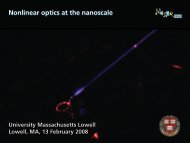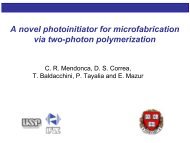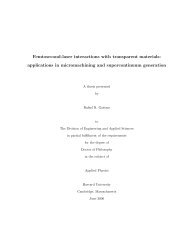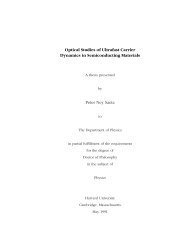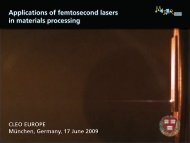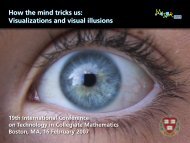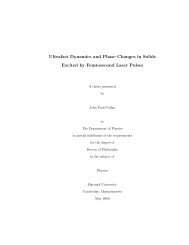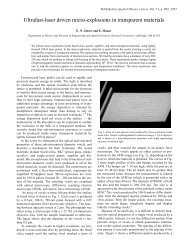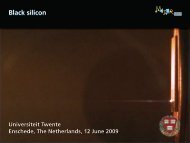Femtosecond laser micromachining in transparent materials
Femtosecond laser micromachining in transparent materials
Femtosecond laser micromachining in transparent materials
- No tags were found...
Create successful ePaper yourself
Turn your PDF publications into a flip-book with our unique Google optimized e-Paper software.
<strong>Femtosecond</strong> <strong>laser</strong> <strong>micromach<strong>in</strong><strong>in</strong>g</strong><strong>in</strong> <strong>transparent</strong> <strong>materials</strong>Bragg Grat<strong>in</strong>gs, Photosensitivity and Pol<strong>in</strong>g<strong>in</strong> Glass Waveguides Topical Meet<strong>in</strong>gKarlsruhe, Germany, 23 June 2010
Rafael GattassLoren CeramiT<strong>in</strong>a ShihMasanao Kamata
and also....Iva MaxwellSan ChungEli GlezerChris SchafferNozomi NishimuraJonathan AshcomJeremy HwangNan ShenDr. André BrodeurDr. Sanjoy KumarDr. Lim<strong>in</strong> TongDr. Prissana ThamboonProf. Igor Khruschev (Aston University)Prof. Denise Krol (UC Davis)Dr. Yossi Chay (Sagitta, Inc.)Dr. S.K. Sundaram (PNNL)Prof. M<strong>in</strong>oru Obara (Keio University)Prof. Don Ingber (Harvard Medical School)Prof. Aravi Samuel (Harvard)
My messagefs <strong>micromach<strong>in</strong><strong>in</strong>g</strong>: great technique for manipulat<strong>in</strong>g matter
Introduction
Introductionfocus <strong>laser</strong> beam <strong>in</strong>side material100 fs<strong>transparent</strong>materialobjectiveOpt. Lett. 21, 2023 (1996)
Introduction
Introductionphoton energy < bandgapnonl<strong>in</strong>ear <strong>in</strong>teraction
Introductionnonl<strong>in</strong>ear <strong>in</strong>teraction provides bulk conf<strong>in</strong>ement
Introductionnonl<strong>in</strong>ear <strong>in</strong>teraction provides bulk conf<strong>in</strong>ementl<strong>in</strong>earabsorptionnonl<strong>in</strong>earabsorption
<strong>Femtosecond</strong> <strong>micromach<strong>in</strong><strong>in</strong>g</strong>Some applications:• data storage• waveguides• microfluidics
Outl<strong>in</strong>e• femtosecond <strong>micromach<strong>in</strong><strong>in</strong>g</strong>• low-energy mach<strong>in</strong><strong>in</strong>g• applications
<strong>Femtosecond</strong> <strong>micromach<strong>in</strong><strong>in</strong>g</strong>Dark-field scatter<strong>in</strong>gobjectivesample
<strong>Femtosecond</strong> <strong>micromach<strong>in</strong><strong>in</strong>g</strong>block probe beam…detectorprobeobjectivesample
<strong>Femtosecond</strong> <strong>micromach<strong>in</strong><strong>in</strong>g</strong>… br<strong>in</strong>g <strong>in</strong> pump beam…pumpdetectorprobeobjectivesample
<strong>Femtosecond</strong> <strong>micromach<strong>in</strong><strong>in</strong>g</strong>… damage scatters probe beampumpdetectorprobeobjectivesample
<strong>Femtosecond</strong> <strong>micromach<strong>in</strong><strong>in</strong>g</strong>scattered signal3signal (a.u.)21fused silica0.1 µJ0–0.2 0 0.2 0.4 0.6 0.8time (µs)
<strong>Femtosecond</strong> <strong>micromach<strong>in</strong><strong>in</strong>g</strong>scattered signal3signal (a.u.)21fused silica1.0 µJ0–0.2 0 0.2 0.4 0.6 0.8time (µs)
<strong>Femtosecond</strong> <strong>micromach<strong>in</strong><strong>in</strong>g</strong>scattered signal3signal (a.u.)21plasmafused silica1.0 µJ0–0.2 0 0.2 0.4 0.6 0.8time (µs)
<strong>Femtosecond</strong> <strong>micromach<strong>in</strong><strong>in</strong>g</strong>scattered signal3signal (a.u.)21fused silica1.0 µJpermanentchange0–0.2 0 0.2 0.4 0.6 0.8time (µs)
<strong>Femtosecond</strong> <strong>micromach<strong>in</strong><strong>in</strong>g</strong>scattered signal3signal (a.u.)21thermaltransientfused silica1.0 µJ0–0.2 0 0.2 0.4 0.6 0.8time (µs)
<strong>Femtosecond</strong> <strong>micromach<strong>in</strong><strong>in</strong>g</strong>vary numerical aperture200threshold (nJ)10000 0.5 1.0 1.5numerical aperture
<strong>Femtosecond</strong> <strong>micromach<strong>in</strong><strong>in</strong>g</strong>vary numerical <strong>in</strong>tensity aperturethreshold: threshold (nJ)200100spot size determ<strong>in</strong>ed bynumerical aperture: 00 0.5 1.0 1.5numerical aperture
<strong>Femtosecond</strong> <strong>micromach<strong>in</strong><strong>in</strong>g</strong>fit gives threshold <strong>in</strong>tensity: I th= 2.5 x 10 17 W/m 2200threshold (nJ)10000 0.5 1.0 1.5numerical aperture
<strong>Femtosecond</strong> <strong>micromach<strong>in</strong><strong>in</strong>g</strong>vary material…threshold <strong>in</strong>tensity (10 17 W/m 2 )4.54.03.53.02.52.00211SF11BK7FSbandgap (eV)CaF 2LiF2 4 6 8 10 12
<strong>Femtosecond</strong> <strong>micromach<strong>in</strong><strong>in</strong>g</strong>…threshold varies with band gap (but not much!)threshold <strong>in</strong>tensity (10 17 W/m 2 )4.54.03.53.02.52.00211SF11BK7FSbandgap (eV)CaF 2LiF2 4 6 8 10 12
<strong>Femtosecond</strong> <strong>micromach<strong>in</strong><strong>in</strong>g</strong>what prevents damage at low NA?
<strong>Femtosecond</strong> <strong>micromach<strong>in</strong><strong>in</strong>g</strong>Compet<strong>in</strong>g nonl<strong>in</strong>ear effects:• multiphoton absorption• supercont<strong>in</strong>uum generation• self-focus<strong>in</strong>g
<strong>Femtosecond</strong> <strong>micromach<strong>in</strong><strong>in</strong>g</strong>why the difference?high NAlow NA
<strong>Femtosecond</strong> <strong>micromach<strong>in</strong><strong>in</strong>g</strong>very different confocal length/<strong>in</strong>teraction lengthhigh NAlow NA
<strong>Femtosecond</strong> <strong>micromach<strong>in</strong><strong>in</strong>g</strong>high NA: <strong>in</strong>teraction length too short for self-focus<strong>in</strong>g
<strong>Femtosecond</strong> <strong>micromach<strong>in</strong><strong>in</strong>g</strong>threshold for supercont<strong>in</strong>uum generation1.0threshold energy (µJ)0.80.60.40.200.01 0.1 1numerical aperture
<strong>Femtosecond</strong> <strong>micromach<strong>in</strong><strong>in</strong>g</strong>threshold for damage1.0threshold energy (µJ)0.80.60.40.200.01 0.1 1numerical aperture
<strong>Femtosecond</strong> <strong>micromach<strong>in</strong><strong>in</strong>g</strong>Po<strong>in</strong>ts to keep <strong>in</strong> m<strong>in</strong>d:• threshold critically dependent on NA• surpris<strong>in</strong>gly little material dependence• avalanche ionization important
Outl<strong>in</strong>e• femtosecond <strong>micromach<strong>in</strong><strong>in</strong>g</strong>• low-energy mach<strong>in</strong><strong>in</strong>g• applications
Low-energy mach<strong>in</strong><strong>in</strong>gthreshold decreases with <strong>in</strong>creas<strong>in</strong>g numerical aperture200threshold (nJ)10000 0.5 1.0 1.5numerical aperture
Low-energy mach<strong>in</strong><strong>in</strong>gless than 10 nJ at high numerical aperture!200threshold (nJ)10000 0.5 1.0 1.5numerical aperture
Low-energy mach<strong>in</strong><strong>in</strong>gamplified <strong>laser</strong>: 1 kHz, 1 mJ1 ms100 fsheat diffusion time: t diff ≈ 1 µs
Low-energy mach<strong>in</strong><strong>in</strong>glong cavity oscillator: 25 MHz, 25 nJ40 ns30 fsheat diffusion time: t diff ≈ 1 µs
Low-energy mach<strong>in</strong><strong>in</strong>g50 µm
Low-energy mach<strong>in</strong><strong>in</strong>gHigh repetition-rate <strong>micromach<strong>in</strong><strong>in</strong>g</strong>:• structural changes exceed focal volume• spherical structures• density change caused by melt<strong>in</strong>g
Low-energy mach<strong>in</strong><strong>in</strong>gamplified <strong>laser</strong>oscillator1 ms40 nsrepetitivecumulative
Low-energy mach<strong>in</strong><strong>in</strong>gamplified <strong>laser</strong>oscillator repetitivecumulative
Low-energy mach<strong>in</strong><strong>in</strong>gthe longer the irradiation…10 2 50 µm
Low-energy mach<strong>in</strong><strong>in</strong>gthe longer the irradiation…10 2 10 350 µm
Low-energy mach<strong>in</strong><strong>in</strong>gthe longer the irradiation…10 2 10 3 10 450 µm
Low-energy mach<strong>in</strong><strong>in</strong>gthe longer the irradiation…10 2 10 3 10 4 10 550 µm… the larger the radius
Low-energy mach<strong>in</strong><strong>in</strong>g12radius (µm)84010 110 210 3number of shots10 410 5
Low-energy mach<strong>in</strong><strong>in</strong>grepetition-rate dependencenumber of pulses10 210 310 410 5 As 2 S 3 , 100 fs, 7 nJ0.11 10repetition rate (MHz)
Low-energy mach<strong>in</strong><strong>in</strong>grepetition-rate dependencenumber of pulses10 210 310 410 5 As 2 S 3 , 100 fs, 7 nJ0.11 10repetition rate (MHz)
Low-energy mach<strong>in</strong><strong>in</strong>grepetition-rate dependencenumber of pulses10 210 310 410 5 As 2 S 3 , 100 fs, 7 nJ0.11 10repetition rate (MHz)
Low-energy mach<strong>in</strong><strong>in</strong>grepetition-rate dependence8radius (µm)64N10 510 410 310 2200.1 1 10 100repetition rate (MHz)As 2 S 3 , 100 fs, 7 nJ
Low-energy mach<strong>in</strong><strong>in</strong>gat high-rep rate: <strong>in</strong>ternal “po<strong>in</strong>t-source of heat”
Outl<strong>in</strong>e• femtosecond <strong>micromach<strong>in</strong><strong>in</strong>g</strong>• low-energy mach<strong>in</strong><strong>in</strong>g• applications
Low-energy mach<strong>in</strong><strong>in</strong>gwaveguide <strong>micromach<strong>in</strong><strong>in</strong>g</strong>Opt. Lett. 26, 93 (2001)
Low-energy mach<strong>in</strong><strong>in</strong>gwaveguide <strong>micromach<strong>in</strong><strong>in</strong>g</strong>Opt. Lett. 26, 93 (2001)
Low-energy mach<strong>in</strong><strong>in</strong>gstructures guide lightOpt. Lett. 26, 93 (2001)
Low-energy mach<strong>in</strong><strong>in</strong>gnear-field profiles10 mm/s–20 0 20x (µm)–20 0 20y (µm)20 mm/s–20 0 20x (µm)–20 0 20y (µm)Sagitta, Inc.
Low-energy mach<strong>in</strong><strong>in</strong>g<strong>in</strong>dex profile at 2.5 mm/s1.5181.516n1.5141.512–20 –10 0 10 20x (µm)Sagitta, Inc.
Low-energy mach<strong>in</strong><strong>in</strong>g<strong>in</strong>dex profile at 10 mm/s1.5181.516n1.5141.512–20 –10 0 10 20x (µm)Sagitta, Inc.
Applicationscurved waveguides
Applicationscurved waveguides
Applicationscurved waveguides
Applicationscurved waveguides
Applicationscurved waveguides
Applicationsphotonic fabrication techniquesfs <strong>micromach<strong>in</strong><strong>in</strong>g</strong>otherloss (dB/cm) < 3 0.1–3bend<strong>in</strong>g radius 36 mm 30–40 mmDn 2 x 10 –3 10 –4 – 0.53D <strong>in</strong>tegration Y N
Applicationsphotonic devices3D splitterBragg grat<strong>in</strong>gdemultiplexerλ 1λ 2λ 3λ 4λ 5amplifier <strong>in</strong>terferometer
Applicationsall-optical sensorsubstrateAppl. Phys. Lett. 87, 051106 (2005)
Applicationsall-optical sensorsubstrateAppl. Phys. Lett. 87, 051106 (2005)
Applicationsall-optical sensorsuspended beamsubstrateAppl. Phys. Lett. 87, 051106 (2005)
Applicationsall-optical sensorglasssuspended beamsubstrateAppl. Phys. Lett. 87, 051106 (2005)
Applicationsall-optical sensorfs <strong>laser</strong>glasslenssuspended beamsubstrateAppl. Phys. Lett. 87, 051106 (2005)
Applicationsall-optical sensorglasswaveguidesuspended beamsubstrateAppl. Phys. Lett. 87, 051106 (2005)
Applicationsall-optical sensorglasswaveguidesuspended beamsubstrateAppl. Phys. Lett. 87, 051106 (2005)
Applicationsall-optical sensorglasswaveguidefibersuspended beamsubstrateAppl. Phys. Lett. 87, 051106 (2005)
Appl. Phys. Lett. 87, 051106 (2005)Applications
Applicationssensor gap20 µmAppl. Phys. Lett. 87, 051106 (2005)
Applicationscalibration15(dB)10loss50–15 –10 –5 0 5 10 15lateral offset (µm)Appl. Phys. Lett. 87, 051106 (2005)
Applicationssensor response to 100 Hz acoustic wave31.0log P (a.u.)21output (a.u.)0.500 50 100time (ms)00 100 200 300 400 500frequency (Hz)Appl. Phys. Lett. 87, 051106 (2005)
Applicationsideal tool for ablat<strong>in</strong>g (liv<strong>in</strong>g) tissue
Applications• standard biochemical tools: species selective• fs <strong>laser</strong> “nanosurgery”: site specific
ApplicationsQ: can we probe the dynamics of the cytoskeleton?
Applicationsact<strong>in</strong> fiber network of a live cell10 µm
Applicationscut a s<strong>in</strong>gle fiber bundle10 µm
Applicationscut a s<strong>in</strong>gle fiber bundle10 µm
Applicationsgap widens with time10 µmt = 10 s
Applicationsdynamics provides <strong>in</strong>formation on <strong>in</strong> vivo mechanics10 µm
Summarygreat tool for• “wir<strong>in</strong>g light”• micromanipulat<strong>in</strong>g the mach<strong>in</strong>ery of life
Summary• important parameters: focus<strong>in</strong>g, energy, repetition rate• nearly material <strong>in</strong>dependent• two regimes: low and high repetition rate• high-repetition rate (thermal) mach<strong>in</strong><strong>in</strong>g fast, convenient
Fund<strong>in</strong>g:Army Research OfficeNational Science Foundationfor a copy of this presentation:http://mazur-www.harvard.edu
Fund<strong>in</strong>g:Army Research OfficeNational Science Foundationfor a copy of this presentation:http://mazur-www.harvard.edu




